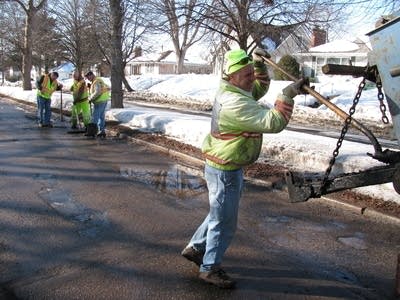Lessons learned from St. Paul's pothole patching crew
Go Deeper.
Create an account or log in to save stories.
Like this?
Thanks for liking this story! We have added it to a list of your favorite stories.

MPR reporter Tim Nelson didn't just complain about this years's pothole plague, he joined a public works crew and headed into bituminous battle.
----
There's this pothole up the road from my house in St. Paul -- I swear my first grader could lie down in it, if he wasn't so finicky about muddy ice water and if his mom didn't get in such a dither about him being in the street.
That pothole is the kind of divot that's showing up on streets in record numbers this year, according to Jim Weeks, a street maintenance supervisor in St. Paul.
Turn Up Your Support
MPR News helps you turn down the noise and build shared understanding. Turn up your support for this public resource and keep trusted journalism accessible to all.
"It's those rains we got in December," he said recently. "You don't notice it right away. It kind of sneaks up on you. Then, all the sudden you've got potholes all over the place."
His colleague, Mike Brennan, says it's even worse than 1997, and maybe the worst he's seen since he went to work for the city 34 years ago.
"It's a war zone," Brennan said.
I like that. I'm thinking of it like nature's own IEDs.
Pothole Reports
Is there a pothole you want fixed? Tell us about it.
But I'm not just complaining. Instead, I decided to do something about it.
St. Paul's asphalt plant just opened on Monday, the first big supplier to have "hot mix" available in the Twin Cities this spring. I headed up there, hopped into Joe Salinas's public works dump truck and headed into bituminous battle.
Here's what I learned.
Lesson one: they've got us surrounded.
For every pothole you see, I guarantee you there's one deeper and bigger a couple blocks away, and it'll be even bigger when you see it on foot.
So street crews are doing some triage. They work the busiest streets, trying to make the difference for the most cars. They skip anything that isn't about two inches deep and isn't right in the roadway.
"Stick to the big ones," said Steve Darwitz, one of the laborers on the crew I was assigned to.
They were working on stretch of Montreal Ave., just east of the Ford assembly plant. It's a heavily used thoroughfare for students and teachers at the nearby Highland Park High School and Nova Classical Academy.
Lesson two: Asphalt isn't even half the battle.
If you really want to fill a pothole, the most important work doesn't get done with a shovel.
Most crews have two people prepping the potholes, with a broom, a high-powered leaf blower and a "war wagon" full of gooey black oil.
It's their job to clean out the gravel and loose tar, the water, and even the occasional car part from the bottom of the potholes. If they can get it reasonably dry, one of the crew will slather the pothole with "tack," a black goo that helps the asphalt (it's not tar) stick to the road.
"A clean pothole is a good pothole," said Weeks, who was running the crew on Montreal Ave. and keeping an eye on my broom work.
Lesson three: When you're filling potholes, you ARE the road. Literally.
The central purpose of the job is lifting a square-end, long-handled shovel full of asphalt out of the bed of a dump truck, which is about armpit high. Do it for very long, and there will be asphalt all over your arms, in your pockets, and maybe even in your hair. You'll be coated with the stuff.
It isn't just the asphalt. Out among the potholes, you are transformed into merely another traffic hazard, whatever the good you're trying to do.
No matter how bright your reflective vest, or where you're standing, drivers think there's plenty of room to squeeze between you, the curb, and maybe even the dump truck you're walking behind. At full speed, if possible.
Lesson four: It's all about the numbers.
Here's one -- pothole season officially starts when asphalt plants can afford to heat outdoor oil reservoirs up to about 300 degrees. If it stays much below freezing, the asphalt is too expensive to make, and won't stay hot enough to work with.
Here's another number -- a truck will take about 8,000 pounds of the asphalt at a time, and it pretty much all has to be moved by hand.
"we checked it once, and you can get about 30 pounds on a shovel," Darwtiz told me.
That's about 260 shovels per load, and a crew can shovel about two loads a day.
The typical pothole takes two or three shovels to fill, although some take a dozen or more. That's about 200 potholes a day, per crew, when you do that math.
Speaking as a tested veteran of the battle against potholes, I can tell you this for sure: It's going to be a long spring behind the wheel in Minnesota this year.





